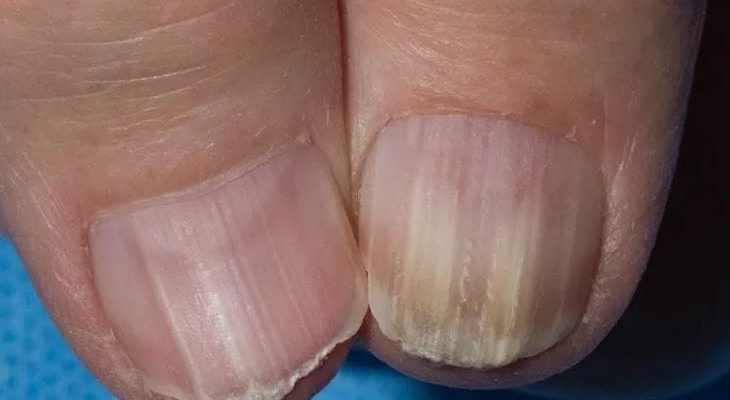FAINT lines on your nails could be a sign you are at risk of cancer, experts claim.
A small thickened area under the nail, along with a red or white band running down it, could indicate a rare genetic disorder that can lead to the disease.
Most changes to your nails are likely a result of nutrient deficiencies.
But a new study has found that these specific issues could be a sign of BAP1 tumour predisposition syndrome.
The rare condition affects a gene that stops the body’s cells from growing rapidly and developing into tumorous masses.
The gene also plays a crucial role in repairing DNA damage to cells, which protects against the growth and spread of cancer cells.
I blamed the weather when Olivia got sick, now we’re making precious Xmas memories
- Split, crack or deform in some way
- Have an irregular pigment
- Swell or get inflamed
- Lift away from your nail bed
- Develop an ulcer or nodule or start to bleed
- Discolour the skin surrounding the nail
In some cases, the nail doesn’t change colour hence why it’s important to take note of anything that looks different or unusual about your nails.
Sun Health Explainer: What is cancer?
The latest study, published on JAMA Dermatology, looked at how many people with BAP1 tumour predisposition syndrome had a nail abnormality.
They found 88 per cent of participants, aged 30 and older, had the condition on multiple nails.
Alexandra Lebensohn, a National Cancer Institute researcher who helped conduct the study, said: “When asked about nail health during a baseline genetic assessment, a very astute patient reported that he had noticed subtle changes in his nail.
“His comment prompted us to systematically evaluate other participants for nail changes and uncover this new finding.”
The experts found a small, thickened area of skin under the nail and a white band running down the nail, which is consistent with onychopapilloma, a type of benign tumour.
The tumour is believed to affect the production and distribution of keratin, a type of protein that the body naturally produces to make nails.
The white lines represent higher levels of keratinisation or areas where the nail has been lifted or distorted by the tumour underneath.
Thirty-nine of 47 participants were found to have onychopapilloma, most of them males and mainly on the thumbnail.
Dr Edward Cowen, a dermatologist at NIH’s National Institute of Arthritis and Musculoskeletal and Skin Diseases, said: “We believe the presence of nail changes that suggest onychopapillomas on multiple nails should prompt consideration of a diagnosis of BAP1 tumour predisposition syndrome.”
The white marks, known medically as leukonychia, can also be caused by an allergic reaction, such as nail polish, gloss, hardener, or polish remover.
White spots may also result from an injury to the nail, such as shutting your fingers in a door or accidentally hitting them with a hammer.
What your hands can reveal about your health
Your hands can tell you a lot about the state of your health.
From what a weak handshake means for your ticker, to how the length of your fingers may indicate a cancer risk, they are able to reveal quite a bit.
GP Dr Sarah Garsed says: “We often start with the hands for examinations when patients come to us.
“We can tell huge amounts from them, so any change to your hands that is prolonged, we recommend you get it checked by your GP.”
Here we look at everything you should be on the lookout for:
Enlarged fingertips
Sudden growth in your fingertips could be a reason to seek advice on your respiratory health.
Dr Garsed says: “This symptom is basically an increase in the tissue around the ends of the fingers.
“This is not something you should ignore as it can be a sign that you have low oxygen in your blood.
“Low oxygen in the blood is always a red flag as it can indicate early signs of lung disease and is something that can be checked with a simple blood test by your GP.”
Weak grip
A weak handshake has long had associations with nervousness or being a bit of a wimp – but it could signal something much more significant.
In fact, a feeble grip can indicate a shorter life expectancy.
A nationwide study published in the British Medical Journal found that those who develop a weak hold in midlife have a 20 per cent higher risk of death from heart and respiratory diseases and cancer.
Long index fingers
The length of your fingers can give indications about your health – especially if you are male.
A study by the International Journal of Medical Sciences found that if an index finger is much longer than the ring finger, it can be a sign of coronary artery disease.
However, men whose index fingers are the same length or longer than their ring fingers are 33 per cent less likely to be diagnosed with prostate cancer, according to a 2010 study published in the British Journal of Cancer.
Red, white or blue fingers
Fingers that turn white, red or blue can suggest poor circulation.
Often a change in temperature from hot to cold, or exposure to long periods of chilly temperatures, causes the colour change, but extreme stress or trauma can also bring it on.
Dr Garsed says: “Regular bouts of extreme colour change in the fingers show your circulation is not functioning correctly and is usually a sign of Raynaud’s disease.
“A lack of adequate blood supply is what causes the fingers to go white or blue, while a sudden return of circulation of blood to the area is what causes redness and swelling.”
Little red rash
Small red bumps or blisters on your hands or wrists can point towards a food allergy.
Sensitivity to nickel – traces of which are found in foods including beans and legumes, chocolate, peanuts, soy, oatmeal and granola – is a common allergy. If you experience any persistent rashes on your hands, it could be a sign.
Dr Garsed says: “You can easily find out if you do have the allergy by simply cutting out foods with nickel in them and seeing if your rash disappears.”
The 22 most common cancer symptoms you should get checked today
There are more than 200 different types of cancer that can cause all sorts of symptoms.
From bloating to losing your voice – it seems like nearly anything can be a sign of the disease.
But 22 indicators crop up most often, according to Cancer Research UK (CRUK).
Spotting these early and seeing a doctor straight away gives you the best chance of survival:
1. Fatigue
2. Aches and pains
3. Bruising
4. Night sweats
5. Weight loss
6. Coughing
7. Lumps or swelling
8. Appetite loss
9. Mole changes
10. Skin changes
11. Heartburn
12. Croaky voice
13. Ulcers
14. Difficulty swallowing
15. Breathlessness
16. Breast changes
17. Bloating
18. Bowel habit changes
19. Blood in poo








